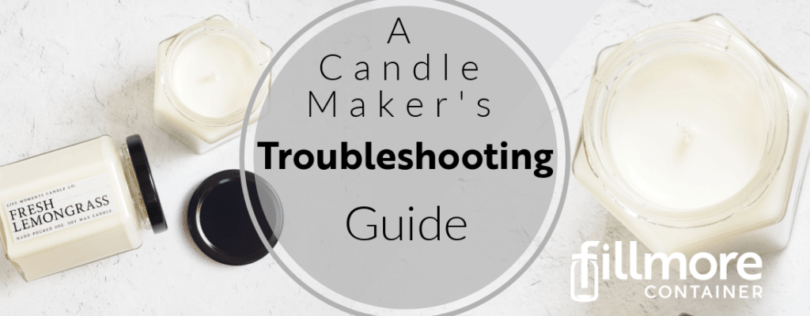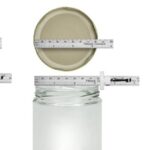
Soy Wax Troubleshooting Guide
While candle making may appear to be a relatively easy project, any experienced candle maker will quickly admit that it takes significant commitment of time and resources to produce a quality candle. In our soy wax troubleshooting guide, we provide some helpful tips for candle makers when working with vegetable-based waxes like soy. Whether you’ve been trying your hand at candles for a bit, or are brand new, it’s helpful to know what to look out for and what measures you can take to avoid some common challenges.
In a previous post, How to get Smooth Tops on your Candles, we addressed causes & remedies related to rough or uneven candle surfaces. Below, we tackle some additional issues.
Moisture in Wax
Soy and coconut blend waxes are made from natural products and while there are industry specs that must be met, there are tolerances. Moisture content can vary from one wax to another and from one case of wax to another. You might observe cloudiness in the wax prior to pouring. The appearance of moisture in a finished candle can also be confused with synerisis (see below). Keep in mind that fragrance load recommendations (from both wax manufacturers and fragrance manufacturers) are based on certain tolerances for best performance. When you are operating outside of any of those recommendations (temperature, fragrance load, other additives, etc), you increase the chance of less than optimal performance even though each of the components are still within specifications. What may work for one batch might not work for another of the identical recipe because of a slight variation in one of the natural components – even though it is still within specs.
Causes: The raw materials may have had more moisture content as a result in weather, harvesting etc. Changes in temperature during shipment to you or while it sets in your storage can cause condensation. (Our facility is climate controlled all year long in order to avoid the impact of temperature changes on our stock.) Once it leaves our facility, we no longer have control over temperatures that the wax may be subject to. Also – see Syneresis below.
Remedy Recommendations:
Upon receiving wax, if you notice moisture, open it up to allow it to air out. As more liners are being taped closed, this may become more important. Be sure that your storage area is low moisture the proper temperature for wax storage.
In your formulations – strive to stay within the parameters provided by the manufacturers.
When you are melting the wax in the melter, allow extra time for additional moisture to evaporate.
Frosting
This is the growth of crystals on the wax surface – usually that of plant-based waxes. It is purely an aesthetics issue and has no impact on candle performance.
Causes: Too drastic a drop in pouring OR cooling temperatures | Excessive fragrance oil
Remedy Recommendations: Bring temperature of jars/container at least up to room temperature | Reduce fragrance load | Reduce pour temperature | Manage cooling temperatures for a slower more even cooling process.
Cracking & Sink Holes
Thin or thick cracks on the surface of the candle which can be around the wick, or extend to the edge of the candle or small hole(s) next to the wick.
Causes: Too drastic a drop in pouring OR cooling temperatures resulting in more rapid contraction of the wax | Air bubbles or voids in the wax.
Remedy Recommendations: Bring temperature of jars/container at least up to room temperature | Reduce pour temperature | Manage cooling temperatures for a slower more even cooling process | Avoid over-stirring to prevent air bubbles from forming and trying to escape | Gently tap or poke a stirrer into the wax right after pouring to release bubbles | Use a heat gun to remelt the top surface.
Syneresis
Also known as fragrance bleed, this is when liquid accumulates on the top surface or bottom of the candle after cooling/curing. This can sometimes be mistaken for moisture in the wax. (See section above.)
Causes: Excessive fragrance oil | Fragrance oil doesn’t bind to the wax because it was added at too low of a temperature.
Remedy Recommendations: When using plant-based wax, add fragrance oil at 185°F and stir very gently | Adjust your fragrance load to the recommended percentages.
Tunneling
Melt pool stops short of the diameter of the container, leaving unmelted/unused wax around the perimeter.
Causes: Too small of a wick to produce a complete melt pool | Too large of a wick which burns too fast, before creating proper melt pool | Too much fragrance oil.
Remedy Recommendations: Adjust wick size | Adjust your fragrance load.
Mushrooming
Clump of carbon buildup on the end of the candle wick that resembles a mushroom.
Causes: Too large of a wick | Too much fragrance oil.
Remedy Recommendations: Adjust wick size | Adjust your fragrance load | Trim wick properly between burns.
Pull-away and Wet Spots
When the candle pulls away from the container causing the appearance of wet spots. This is only visible in clear containers.
Causes: Reduced adhesion | Too rapid of a cooling process.
Remedy Recommendations: Clean glass containers prior to filling | Bring temperature of jars/container at least up to room temperature | Reduce pour temperature | Manage cooling temperatures for a slower more even cooling process.
See more candle making resources:
- Wholesale Candle Wax (Soy and Coconut)
- TruScent Fragrance Oils for Candles and Personal Care Products
- Candle Wicks – ECO, HTP, Premier, CD (Stabilo)





0 Comments